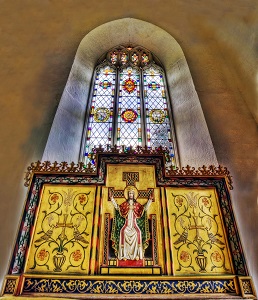Founded in 12th Century, most of the building's fabric dates from around the 13th Century and was dedicated by Bishop Bronescombe in 1259. The interior was remodelled in 1885. The church is in a Cruciform plan with Lancet windows (recently restored). The interior is generally Gothic but there are several 16th and 17th Century features inside along with the stained glass windows. The Church is Grade I listed and was recorded in the Doomsday Book.
The Parish of Ashcombe has its roots in our most ancient history. We know that in Saxon times the land was held by one Alric and the Doomsday Book records that the manor was held by Randulphus de Pomaria. It has been suggested that its dedication to St. Nectan, a Celtic saint, is strong evidence that there was a church in the valley before the recorded dedication of the church on 22nd November 1259 by Bishop Bronescombe Certainly the dedication is one of great antiquity rather than a relatively modern fantasy for, unusually, the church is named in an early will, that of John Comin dated 18th January 1543.
St Nectan is a Grade I church. The listing states that it is 'A rare example of a largely thirteenth century church'. Over the centuries there have been a number of additions and subtractions. The principle addition took place in the 15th century when the Kirkham family (who held the property from the time of Edward the First) enlarged the north transept into an aisle. The Kirkham family also installed rather unusual oak pews, 'unlike any others in the Diocese'. During the incumbency of the Rev’d. W. H. Palk (1820-85) the church underwent a zealous restoration and some of the medieval features, including the screen, were removed. At this time (1824-5) the architect Salvin was engaged on the building of nearby Mamhead House, and it is clear that he was involved in the restoration work and was certainly commissioned to design a pulpit, reading desk and reredos, although these do not survive. The 13th century tower houses three bells supported on, 'the oldest basically unaltered medieval bell frame in the country'. Since 1936 the Church has benefited from a number of gifts to its internal fittings, most notably from Brigadier Sir Ralph and Lady Rayner. The structure has not been altered, and the whole effort of the congregation has been to keep the building in good repair.


